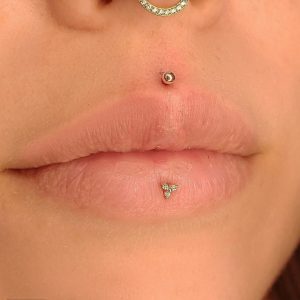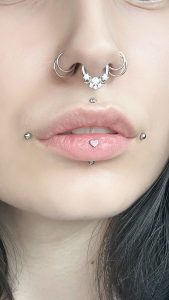Inner lip piercings are a type of body modification where jewelry is inserted through the inner portion of the lip. They can be a stylish addition to your look, but it’s important to consider all the factors before getting one.
This article will explore inner lip piercings in detail. We’ll cover the procedure, aftercare, risks and considerations, and alternatives to inner lip piercings.
So, if you’re curious about inner lip piercing, keep reading!
Inner Lip Piercing Procedure
The inner lip piercing procedure is generally performed by a professional piercer. Here’s a general overview of what to expect:
- Consultation: You’ll discuss your desired placement and jewelry with the piercer.
- Marking: The piercer will mark the exact spot for the piercing to ensure symmetry and accuracy.
- Cleaning: The piercing area will be thoroughly disinfected to minimize infection risk.
- Piercing: A hollow needle will be used to create a clean puncture through the designated spot inside your lip.
- Jewelry Insertion: The chosen jewelry, typically a labret stud, will be gently inserted into the piercing.
- Aftercare Instructions: The piercer will provide detailed cleaning and care instructions.
Remember, this is a general guideline. The specific steps may vary depending on the piercer’s technique.
Inner Lip Piercing Aftercare
Proper aftercare is crucial for a healthy and successful inner lip piercing healing process. Here are some essential aftercare tips:
- Clean the piercing regularly with a saline solution or a piercer-recommended cleaning product.
- Avoid excessive touching or manipulating the piercing with your tongue or hands.
- Rinse your mouth with alcohol-free mouthwash after meals and before bed.
- Use a soft toothbrush and avoid brushing directly on the piercing.
- Avoid harsh soaps, irritants, and spicy foods around the piercing while healing.
- Stay away from swimming pools, hot tubs, and other bodies of water until the piercing heals completely.
- Be mindful of snagging the jewelry on utensils, straws, or your teeth.
Following these guidelines will help your inner lip piercing heal properly and reduce the risk of complications.
Healing Timeline
An inner lip piercing typically takes 2 to 4 months to heal completely. During this time, it’s essential to be patient and diligent with aftercare. Some tenderness, swelling, and slight bleeding are normal in the initial days. If you experience any excessive pain, pus discharge, or persistent bleeding, consult your piercer or a healthcare professional immediately.
Risks and Considerations
Inner lip piercings come with potential risks, so it’s important to weigh the pros and cons before getting one. Here’s what to consider:
- Infection: Improper aftercare or using non-sterile equipment can lead to infection.
- Allergic Reaction: Some people may be allergic to the jewelry material, causing irritation or redness.
- Bleeding: Bleeding is a normal part of the piercing process, but excessive bleeding should be addressed by a piercer.
- Chipped or Broken Teeth: The jewelry can bump against your teeth, potentially causing chips or cracks.
- Speech Impediment: The piercing may cause temporary or permanent speech difficulties.
- Gum Recession: In some cases, the piercing can irritate the gums and lead to recession.
If you have any concerns about these risks, discuss them with a professional piercer before getting an inner lip piercing.
Alternatives to Inner Lip Piercings
If you’re interested in lip piercings but unsure about inner lip piercings, there are alternatives to consider:
Labret Piercing:
This classic piercing goes through the center of the labret, below the bottom lip.
Monroe Piercing:
This adorns the right side of the philtrum, above the center of the upper lip.
Medusa Piercing:
This one is placed in the center of the philtrum, directly above the cupid’s bow.
Fake Lip Piercings:
These clip-on or magnetic options offer a temporary way to experience the look of a lip piercing without the commitment.
These are just a few examples, and there are many other lip piercings available.
Inner lip piercings can be a stylish form of body modification, but they’re not for everyone. By understanding the procedure, aftercare, risks, and alternatives, you can make an informed decision about whether this type of piercing is right for you.
If you decide to move forward, prioritize finding a reputable piercer who will ensure a safe and successful piercing experience.

Jewelry Options and Customization
Inner lip piercings offer some unique customization options when it comes to jewelry. Here’s a look at some factors to consider:
-
Material: Implant-grade titanium or surgical steel are generally recommended for initial jewelry to minimize allergy risks. Once healed, you can explore other options like biocompatible plastics or gold.
-
Size: The size of the labret stud will depend on your anatomy and comfort level. Discuss options with your piercer to find the perfect fit.
-
Style: While studs are most common for inner lip piercings, curved barbells can also be an option. Consider the look you’re going for and discuss it with your piercer.
Remember, prioritizing biocompatible materials for initial jewelry is crucial for safe healing.
Finding a Reputable Piercer
Choosing a professional and experienced piercer is essential for a safe and successful inner lip piercing experience. Here are some tips for finding a reputable piercer:
-
Ask for Recommendations: Get referrals from friends with piercings or search online review platforms focusing on reputable piercing studios.
-
Check Credentials: Ensure the piercer is a member of a reputable piercing association and has a valid business license.
-
Review Portfolio: Look at the piercer’s online portfolio or social media pages to assess their experience and hygiene standards. Look for photos showcasing proper aseptic techniques.
-
During Consultation: Discuss your desired placement, aftercare routine, and any concerns you may have. A professional piercer will answer your questions thoroughly and ensure you understand the procedure fully.
By following these tips, you can increase your chances of finding a qualified piercer who prioritizes safety and hygiene.
Inner Lip Piercing and Oral Health
Inner lip piercings can potentially impact your oral health. Here’s what to consider:
-
Gum Irritation: The piercing may irritate the gums, especially during the healing process. This can lead to gum inflammation or bleeding.
-
Chipped or Broken Teeth: The jewelry can bump against your teeth, potentially causing chips or cracks. Be mindful of the jewelry’s placement and avoid excessive playing with the piercing.
-
Brushing and Flossing: Maintaining proper oral hygiene is crucial. Be gentle while brushing and flossing around the piercing to avoid irritation.
If you experience any persistent gum problems, chipped teeth, or difficulty maintaining oral hygiene, consult with a dentist or your piercer for guidance.
Conclusion
Inner lip piercings can be a unique and personal form of body modification, but it’s important to carefully consider all the factors involved. Understanding the procedure, aftercare, risks, and alternatives empowers you to make an informed decision.
If you decide to move forward, prioritize finding a reputable piercer who will ensure a safe and successful piercing experience.



